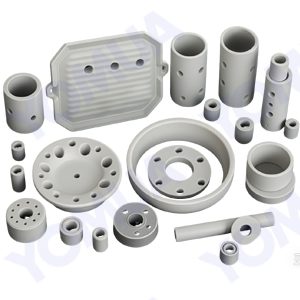Boron nitride (BN) ceramics, prized for their unique properties like thermal stability, chemical inertness, and lubricity, face several key challenges that hinder their widespread use. Here’s a breakdown of eleven issues and potential solutions:

Issures and solutions:
1. Mechanical Weakness:
- Issue: BN ceramics, especially in pure form, lack the strength and toughness of other advanced ceramics, limiting their structural applications.
- Solution: Developing composite materials with reinforcing phases (fibers, particles), optimizing microstructure (grain size, morphology), and achieving high density through improved manufacturing processes.
2. Sintering Difficulties:
- Issue: BN’s strong covalent bonds and low self-diffusion make it difficult to densify during sintering.
- Solution: Employing advanced sintering techniques like hot pressing or spark plasma sintering (SPS), or adding sintering aids to promote densification.
3. Thermal Conductivity Anisotropy:
- Issue: While hexagonal BN (h-BN) offers good thermal conductivity, it’s anisotropic (directionally dependent) and lower than cubic BN (c-BN).
- Solution: Controlling the microstructure and grain orientation of h-BN, or utilizing c-BN where higher, isotropic thermal conductivity is needed.
4. Oxidation Susceptibility:
- Issue: BN can oxidize at high temperatures, degrading its properties.
- Solution: Applying protective coatings or developing BN-based composites with enhanced oxidation resistance.
5. Cost and Scalability:
- Issue: High production costs and difficulties in scaling up manufacturing limit wider adoption.
- Solution: Researching and developing cost-effective synthesis methods and optimizing production processes.
6. Machinability and Surface Finish:
- Issue: While h-BN is relatively machinable, achieving a fine surface finish can be difficult.
- Solution: Using advanced machining techniques and optimizing machining parameters for better surface finishes.
7. Electrical Insulation (and Tailoring):
- Issue: BN’s excellent electrical insulation can be a limitation when conductivity is required.
- Solution: Developing BN composites with conductive fillers to tailor electrical properties for specific applications.
8. Thermal Shock Resistance:
- Issue: While generally good, thermal shock resistance can still be a concern in extreme thermal cycling.
- Solution: Enhancing thermal shock resistance through microstructural engineering and composite formation.
9. Environmental and Health Concerns:
- Issue: Production and disposal may have environmental and health impacts.
- Solution: Developing sustainable production methods and recycling strategies.
10. Phase Stability:
- Issue: BN exists in multiple phases, and controlling the desired phase during synthesis can be challenging.
- Solution: Optimizing synthesis conditions and using phase-stabilizing additives.
11. Adhesion and Coating Challenges:
- Issue: Achieving good adhesion of BN coatings to substrates can be difficult.
- Solution: Utilizing surface treatments and intermediate layers to improve adhesion.

The Summary Table:
Challenges and Solutions for Boron Nitride (BN) Ceramics
| Issue | Description | Solution(s) |
|---|---|---|
| Mechanical Strength | Low strength and toughness compared to other ceramics, limiting structural applications. | Composite materials (reinforcing phases), microstructure optimization, improved densification. |
| Sintering/Densification | Difficult to sinter to high density due to covalent bonding and low self-diffusion. | Advanced sintering techniques (hot pressing, SPS), sintering aids. |
| Thermal Conductivity | Anisotropic thermal conductivity; h-BN lower than c-BN. | Microstructure/grain orientation control (h-BN), use of c-BN where higher conductivity is required. |
| Oxidation Resistance | Oxidizes at high temperatures, degrading properties. | Protective coatings, BN-based composites with improved oxidation resistance. |
| Cost & Scalability | High production costs and challenges in scaling manufacturing. | Cost-effective synthesis methods, optimized production processes. |
| Machinability/Surface | While h-BN is machinable, achieving fine surface finish is challenging. | Advanced machining techniques, optimized machining parameters. |
| Electrical Insulation | Excellent insulation can be a limitation when conductivity is needed. | BN composites with conductive fillers. |
| Thermal Shock Resistance | While generally good, can be a limitation in extreme thermal cycling. | Microstructural engineering, composite formation. |
| Environmental/Health | Production and disposal may have environmental and health impacts. | Sustainable production methods, recycling strategies. |
| Phase Stability | BN exists in multiple phases; controlling the desired phase can be challenging. | Optimized synthesis conditions, phase-stabilizing additives. |
| Adhesion/Coating | Achieving good adhesion of BN coatings to substrates can be difficult. | Surface treatments, intermediate layers. |
Addressing these challenges requires a multidisciplinary approach, combining materials science, chemistry, and engineering expertise. Overcoming these hurdles will enable BN ceramics to be more effectively utilized in a wide range of applications, from high-temperature insulators and lubricants to protective coatings and electronic components.
Conclusion:
Boron nitride (BN) ceramics, with their unique combination of properties like thermal stability, chemical inertness, and lubricity, hold immense potential for diverse applications. However, realizing this potential hinges on overcoming several key challenges. As outlined, these challenges span mechanical limitations, processing difficulties, and application-specific requirements. While BN’s inherent brittleness and sintering complexities have historically limited its use, ongoing research and development are yielding promising solutions. The development of reinforced composites, advanced sintering techniques, and a deeper understanding of microstructure-property relationships are paving the way for improved mechanical performance and tailored thermal properties. Addressing issues like oxidation resistance, cost, and scalability is also crucial for broader adoption. By continuing to invest in research and innovation, particularly in areas like novel processing methods, surface modification, and composite design, we can unlock the full potential of BN ceramics. These efforts will not only enhance existing applications but also open up new possibilities in fields ranging from advanced electronics and thermal management to cutting tools, lubricants, and high-temperature materials. Ultimately, overcoming these challenges will solidify BN ceramics as indispensable materials for a wide range of demanding applications.